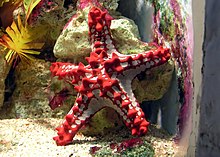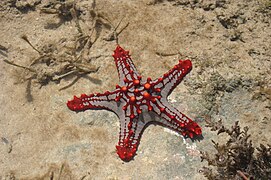
Starfish or sea stars are star-shaped echinoderms belonging to the class Asteroidea. Common usage frequently finds these names being also applied to ophiuroids, which are correctly referred to as brittle stars or basket stars. Starfish are also known as asteroids due to being in the class Asteroidea. About 1,900 species of starfish occur on the seabed in all the world's oceans, from warm, tropical zones to frigid, polar regions. They are found from the intertidal zone down to abyssal depths, at 6,000 m (20,000 ft) below the surface.

A tide pool or rock pool is a shallow pool of seawater that forms on the rocky intertidal shore. Many of these pools exist as separate bodies of water only at low tide.
Reef safe is a distinction used in the saltwater aquarium hobby to indicate that a fish or invertebrate is safe to add to a reef aquarium. There is no fish that is completely reef safe. Every fish that is commonly listed as reef safe are species that usually do not readily consume small fish or invertebrates. Fish listed as reef safe also do not bother fellow fish unless in some cases, for instance tangs, they do not get along with conspecifics and sometimes fish with similar color or body shape. Every fish has a personality, is different, and, in some cases, are opportunistic feeders. Tangs, which by most accounts are reef safe, may in adulthood eat some crustaceans shortly after they molt. Many larger predatory fish, for instance eels and pufferfish, will adapt very well to a reef tank and will be problem-free as long as they have sizable tank-mates and no crustaceans. Some aquarists have also had success in keeping smaller fish with predatory ones in reef tanks by adding the smaller fish at night, sometimes with newly rearranged rockwork.

Synanceia verrucosa is a species of venomous fish in the family Synanceiidae, commonly known as the reef stonefish. It is the most widespread species of stonefish, mostly found in shallow waters of the Red Sea and the Indo-Pacific. It is the deadliest fish in the sea, with incredibly effective venom which can be lethal to humans.

The intertidal zone, also known as the foreshore or seashore, is the area above water level at low tide and underwater at high tide. This area can include several types of habitats with various species of life, such as seastars, sea urchins, and many species of coral. Sometimes it is referred to as the littoral zone, although that can be defined as a wider region.

Linckia laevigata is a species of sea star in the shallow waters of tropical Indo-Pacific.
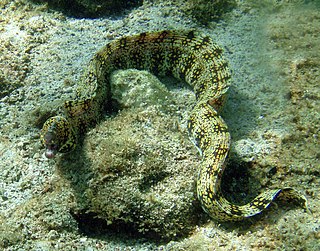
The snowflake moray also known as the clouded moray among many various vernacular names, is a species of marine fish of the family Muraenidae.
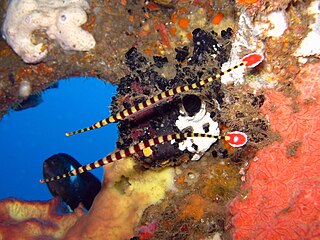
The banded pipefish or ringed pipefish is a species of fish in the Syngnathidae family.

Culcita novaeguineae is a species of starfish. It has short arms and an inflated appearance and resembles a pentagonal pincushion. It is variable in colour and can be found in tropical warm waters in the Indo-Pacific.

Culcita is a genus of cushion stars. They are found in tropical waters. Some are kept in home aquariums.

Culcita schmideliana, commonly known as the spiny cushion star, is a species of pin-cushion star. It has a variety of base colors and often patches of a different color. It is pentagonal in shape and lives in the tropical Indo-Pacific. This species is rarely kept by hobby aquarists.

The Lakes Aquarium is an aquarium in the village of Lakeside on the southern shore of Windermere, Cumbria, England. It is one of the docking points of Windermere Lake Cruises and also at one end of the Lakeside and Haverthwaite Railway. It is the third most visited paying tourist attraction in Cumbria

Sea Life Bangkok Ocean World is an aquarium in Bangkok, Thailand, the largest in South East Asia. It covers approximately 10,000 square meters (110,000 sq ft) with hundreds of different species on display in exhibits totalling about 5,000,000 liters (1,300,000 U.S. gal).

Choriaster is monotypic genus in the family Oreasteridae containing the single species Choriaster granulatus commonly known as the granulated sea star. Other common names include big-plated sea star and doughboy starfish. This species is harmless to humans.
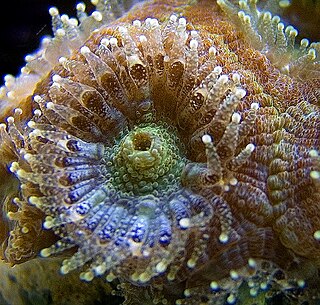
Micromussa lordhowensis, previously known as the 'Acan Lord', is a species of stony coral in the family Lobophylliidae. It is a widespread and common coral with large polyps occurring on shallow reefs in the Indo-Pacific Ocean. It was originally classified under the genus Acanthastrea, and reclassified under the genus Micromussa in 2016.
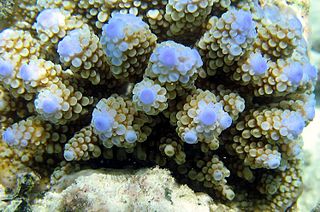
Acropora nasuta is a species of branching stony coral in the family Acroporidae. It is native to the western and central Indo-Pacific where it is found in shallow reef habitats. Like other corals of the genus Acropora, it is susceptible to coral bleaching and coral diseases and the IUCN has listed it as being "Near Threatened".
Stylaraea is a genus of marine stony corals in the family Poritidae. It is a monotypic genus and the only species is Stylaraea punctata. This coral is native to shallow tidal pools in tropical parts of the Indian and Pacific Oceans.

Fromia indica, commonly called Indian sea star or red starfish, is a species of marine starfish belonging to the family Goniasteridae.

Heliofungia actiniformis is a solitary species of mushroom coral, a large polyp stony coral in the family Fungiidae. This coral is found in shallow water in the Indo-Pacific region. It is a zooxanthellate species. It is a popular coral in the reef aquarium trade; wild populations are threatened by disease, climate change, and over-collecting, and the species is considered vulnerable by the IUCN.

Vittina turrita is a species of aquatic snail, a gastropod mollusk in the family Neritidae.
